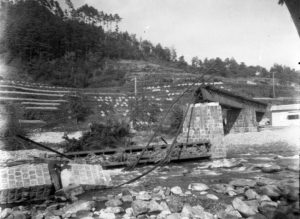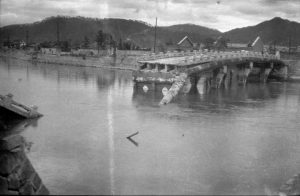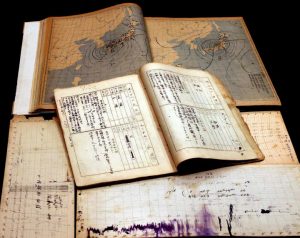Documenting Hiroshima of 1945: September 17, as A-bombed city suffers torrential rains, fierce winds, “I heard people calling for help”
Sep. 17, 2024
by Minami Yamashita, Staff Writer
On September 17, 1945, six weeks after the atomic bombing, Hiroshima was hit by the Makurazaki Typhoon, among the three most powerful typhoons of Japan’s Showa period (1926–1989). Amidst the torrential rains and fierce winds, Tsunehiro Tomoda, nine at the time, was crossing Hijiyama Bridge (spanning Hiroshima’s present-day Naka and Minami Wards). “I held on to Mr. Kanayama’s belt so I wouldn’t get blown away. It was scary, with Mr. Kanayama holding on to the bridge railing as he walked,” said Mr. Tomoda, now 88, who lives in Kadoma City, Osaka Prefecture.
Mr. Tomoda was an A-bomb orphan. After the atomic bombing, he was able to reunite with a Korean man by the name of Saburo Kanayama, who had been boarding at his home in the area of Ote-machi (in the city’s present-day Naka Ward), and they began living together in a shack measuring around two tatami mats near the west end of Miyuki Bridge (also in Naka Ward). The shack was not solid enough to withstand the typhoon, and when rainwater started to leak in through the walls, the two headed for the house of a friend of Mr. Kanayama located at the foot of Hijiyama Hill.
They arrived drenched to the skin and were provided with clothes to change into. Amid the unfolding natural disaster after the atomic bombing, Mr. Kanayama and his friend from the same hometown discussed in Korean whether they should take Tsunehiro to the Korean Peninsula. The friend’s wife interpreted for the boy, to whom she said, “Go with Mr. Kanayama.” Mr. Tomoda “didn’t even know where Korea was,” but he had no choice but to follow Mr. Kanayama. On the morning of September 18, after the typhoon had passed, they set off for the Korean Peninsula.
In Hiroshima City, maximum wind gust speed was measured at 45.3 meters per second and maximum wind velocity at 30.2 meters per second, with maximum rainfall reaching 57.1 millimeters per hour. Infrastructure and buildings that had barely withstood destruction from the atomic bombing were damaged in the typhoon. The bridge girders near the west end of Taisho Bridge over the Enko River (in Hiroshima’s present-day Minami Ward) were washed away.
“I heard the sound of water flowing and people calling for help from outside,” said Makiko Kato, 95, who is a resident of Hiroshima’s Higashi Ward. At the time of the bombing, she was 16 and at home in the area of Kamiyanagi-machi (in the city’s present-day Naka Ward). On September 17, she and her family were staying on the second floor of a friend’s storehouse in the area of Furuichi-cho (now part of Asaminami Ward). At night, the embankment of the Ota River collapsed, causing flooding in and around Furuichi-cho in the downstream reaches of the river. The first floor of the storehouse was flooded. According to Ms. Kato, “The structure was built solidly, so we survived. The houses around us were all swept away.”
At the Ono Army Hospital (in present-day Hatsukaichi City), where A-bomb survivors had been admitted, a mudslide killed 156 people. Among the victims were 11 members of a team from Kyoto Imperial University (present-day Kyoto University) who were based at the hospital to survey the devastation caused by the atomic bombing. The number of victims throughout Hiroshima Prefecture exceeded 2,000 people.
At 10 a.m. on September 17, the local meteorological observatory had issued a special warning, but the information was not adequately conveyed to the public because the communications capacity damaged in the war had not yet been fully restored. Isao Kita, then chief engineer at the Hiroshima Regional Meteorological Observatory (present-day Hiroshima Local Meteorological Office) who died in 2001 at the age of 89, wrote in a personal account that the causes of the widespread damage were, “First, the torrential rains, and second, inadequate disaster prevention measures due to the country’s defeat in the war.”
Mr. Kita took photographs of the damage caused by the Makurazaki Typhoon as a member of the meteorological team of a task force formed in September by a Ministry of Education research council to study destruction from the atomic bombing. At the end of his account, Mr. Kita wrote, “The 20th year of Showa (1945) was the worst year for the people of Hiroshima Prefecture.” The rotary press at the Chugoku Shimbun’s plant in Nukushina (in Hiroshima’s present-day Higashi Ward) had also been damaged by flooding. After completing printing of its September 18 newspaper, the company once again became unable to publish the newspaper on its own.
(Originally published on September 17, 2024)
On September 17, 1945, six weeks after the atomic bombing, Hiroshima was hit by the Makurazaki Typhoon, among the three most powerful typhoons of Japan’s Showa period (1926–1989). Amidst the torrential rains and fierce winds, Tsunehiro Tomoda, nine at the time, was crossing Hijiyama Bridge (spanning Hiroshima’s present-day Naka and Minami Wards). “I held on to Mr. Kanayama’s belt so I wouldn’t get blown away. It was scary, with Mr. Kanayama holding on to the bridge railing as he walked,” said Mr. Tomoda, now 88, who lives in Kadoma City, Osaka Prefecture.
Mr. Tomoda was an A-bomb orphan. After the atomic bombing, he was able to reunite with a Korean man by the name of Saburo Kanayama, who had been boarding at his home in the area of Ote-machi (in the city’s present-day Naka Ward), and they began living together in a shack measuring around two tatami mats near the west end of Miyuki Bridge (also in Naka Ward). The shack was not solid enough to withstand the typhoon, and when rainwater started to leak in through the walls, the two headed for the house of a friend of Mr. Kanayama located at the foot of Hijiyama Hill.
They arrived drenched to the skin and were provided with clothes to change into. Amid the unfolding natural disaster after the atomic bombing, Mr. Kanayama and his friend from the same hometown discussed in Korean whether they should take Tsunehiro to the Korean Peninsula. The friend’s wife interpreted for the boy, to whom she said, “Go with Mr. Kanayama.” Mr. Tomoda “didn’t even know where Korea was,” but he had no choice but to follow Mr. Kanayama. On the morning of September 18, after the typhoon had passed, they set off for the Korean Peninsula.
In Hiroshima City, maximum wind gust speed was measured at 45.3 meters per second and maximum wind velocity at 30.2 meters per second, with maximum rainfall reaching 57.1 millimeters per hour. Infrastructure and buildings that had barely withstood destruction from the atomic bombing were damaged in the typhoon. The bridge girders near the west end of Taisho Bridge over the Enko River (in Hiroshima’s present-day Minami Ward) were washed away.
“I heard the sound of water flowing and people calling for help from outside,” said Makiko Kato, 95, who is a resident of Hiroshima’s Higashi Ward. At the time of the bombing, she was 16 and at home in the area of Kamiyanagi-machi (in the city’s present-day Naka Ward). On September 17, she and her family were staying on the second floor of a friend’s storehouse in the area of Furuichi-cho (now part of Asaminami Ward). At night, the embankment of the Ota River collapsed, causing flooding in and around Furuichi-cho in the downstream reaches of the river. The first floor of the storehouse was flooded. According to Ms. Kato, “The structure was built solidly, so we survived. The houses around us were all swept away.”
At the Ono Army Hospital (in present-day Hatsukaichi City), where A-bomb survivors had been admitted, a mudslide killed 156 people. Among the victims were 11 members of a team from Kyoto Imperial University (present-day Kyoto University) who were based at the hospital to survey the devastation caused by the atomic bombing. The number of victims throughout Hiroshima Prefecture exceeded 2,000 people.
At 10 a.m. on September 17, the local meteorological observatory had issued a special warning, but the information was not adequately conveyed to the public because the communications capacity damaged in the war had not yet been fully restored. Isao Kita, then chief engineer at the Hiroshima Regional Meteorological Observatory (present-day Hiroshima Local Meteorological Office) who died in 2001 at the age of 89, wrote in a personal account that the causes of the widespread damage were, “First, the torrential rains, and second, inadequate disaster prevention measures due to the country’s defeat in the war.”
Mr. Kita took photographs of the damage caused by the Makurazaki Typhoon as a member of the meteorological team of a task force formed in September by a Ministry of Education research council to study destruction from the atomic bombing. At the end of his account, Mr. Kita wrote, “The 20th year of Showa (1945) was the worst year for the people of Hiroshima Prefecture.” The rotary press at the Chugoku Shimbun’s plant in Nukushina (in Hiroshima’s present-day Higashi Ward) had also been damaged by flooding. After completing printing of its September 18 newspaper, the company once again became unable to publish the newspaper on its own.
(Originally published on September 17, 2024)










